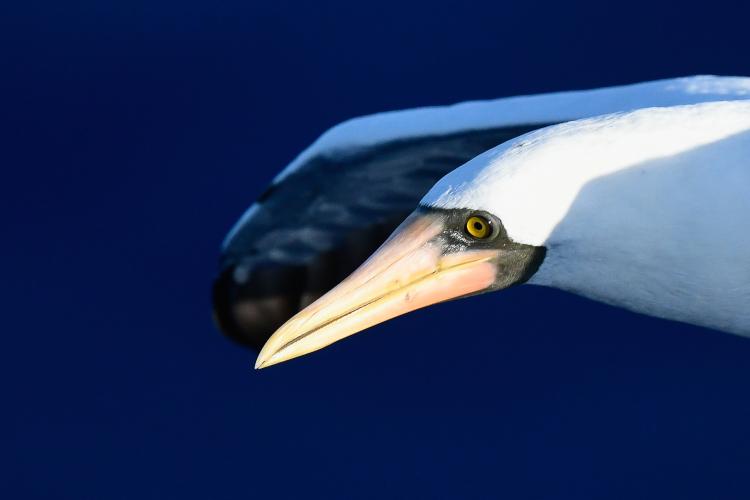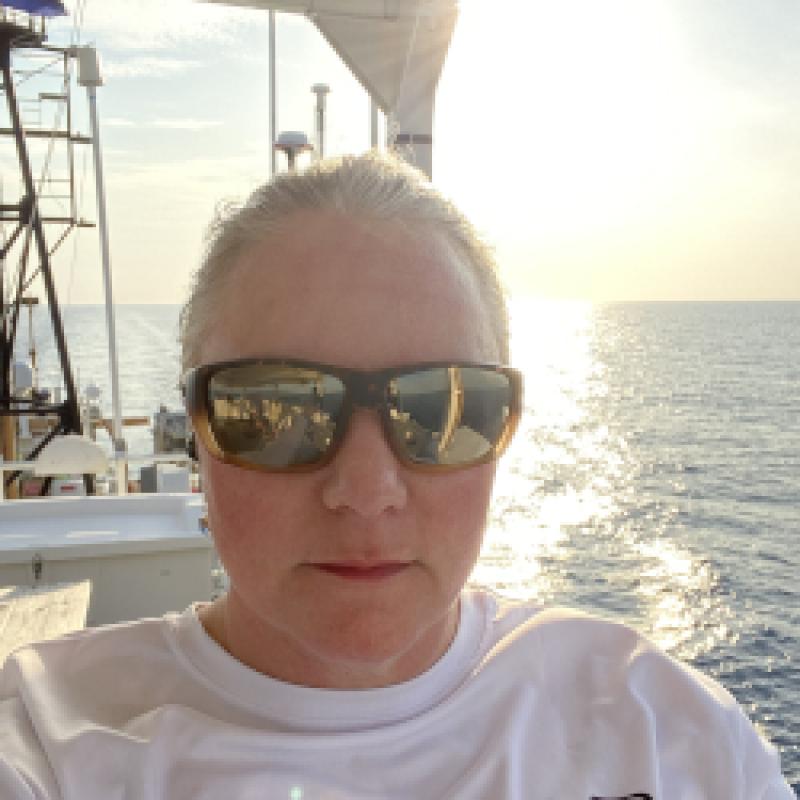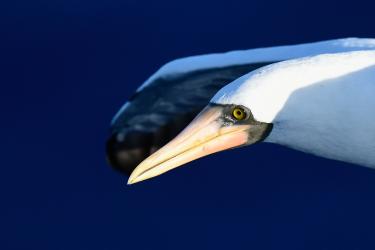Day 35
Greetings from the western Gulf of Mexico,
We spent the day cruising back and forth through an anticyclonic Loop Current eddy. These 200 to 400 meter large eddies frequently occur in the western Gulf and can last for months. The seas were variable, with an average sea state of less than 3. The day brought few clouds and abundant sunshine. Typically the eddy edges can make for a flurry of activity since they stir up lots of nutrients and prey for birds and mammals. Today did not disappoint.
It was a busy day for the acoustics team, breaking the daily record with 31 detections! Sperm whales and various dolphin species dominated the detections. But, the highlight of the day was an hour that contained detections of two unidentified dolphin groups, beaked whales, dwarf or pygmy sperm whales, and sperm whales, all overlapping at the same time! Another great day out in the deep!
The bird team had an interesting day with small blips of bird activity and large swaths of flying fish activity! The morning began with gorgeous, teal water. It was clear enough for us to observe a number of moon jellyfish, sea nettles, and one large jellyfish, either lion's mane or pink meanie. The sea conditions seemed perfect for seabirds, but somehow we didn't encounter many. The most numerous birds were about a dozen distant sooty terns. These were followed by seven brown boobies, five Audubon's shearwaters, then four band-rumped storm-petrels. We also saw one unidentified storm-petrel and two Atlantic Cory's shearwaters. The surprise bird of the day was a young white ibis flying high above the sea in a westerly direction. It didn't even give our sturdy rest platform a glance as it passed.
The mammal visual team seemed to have found many of the Gulf’s endangered sperm whales—accounting for 15 of the 29 sightings! All the sperm whale clusters seemed to be on asynchronous dive cycles. We often saw flukes out of the water (indicating the start of a long, deep dive) followed by another animal or two on the same spot not long after the first animal, indicating multiple individuals following each other. Earlier in the day before the flurry of sperm whale activity, we encountered a few groups of pantropical spotted dolphins. We saw at least one group of dwarf or pygmy sperm whales not long before the acoustics team heard them. We also spotted some melon-headed whales and another group that was either melon-headed whales or pygmy killer whales.
Speaking of sperm whales…today marks the 15 year anniversary of when we caught a giant squid during a sperm whale prey study aboard NOAA Ship Gordon Gunter!
Day 36
Good evening,
Thursday was a relatively slow day for the three teams aboard the survey. Sighting conditions were decent for most of the day, with an average sea state around 3 and mostly sunny skies.
The marine mammal visual team only had two identified sightings, a dwarf or pygmy sperm whale that popped up close to the ship, and some bottlenose dolphins that made their way toward the bow. It was also a quieter day for acoustics in comparison to Day 35 with a total of 9 detections. The morning started with a couple of sperm whale detections followed by a beaked whale. The afternoon was filled with distant dolphin whistles.
All was quiet on the western front, or so say the birders. While there were birds around to see, mostly in the form of seven brown boobies and their antics, there were long stretches where birds were absent from the survey zone. There were occasional distant sooty terns, and we sometimes got lucky enough to catch a glimpse of passing songbird migrants, but all were too far to confirm the species. The closest songbirds we could identify were barn swallows. We also saw royal terns, laughing gulls, and a single passing common tern. The only tube-noses we saw today were Cory’s shearwaters and one Scopoli’s shearwater.
In an entirely different taxon of animals seen today, we had a swarm of wandering gliders that seemed to escort the vessel from the start of the day until mid-afternoon. Did you know that wandering gliders are one of the most ubiquitous dragonflies in the world? They live on all continents except Antarctica and undergo an annual, multi-generational migration of 11,200 miles—one of the farthest known migrations of all insects!
Heading into Friday and possibly through the weekend, we will be retrieving up to ten sound traps used for passive acoustic monitoring—most of which were deployed during this survey last year. Stay tuned!
Day 37
Good evening survey followers,
We shifted our objectives for the day. In July 2023 and March 2024, a total of ten passive acoustic listening devices known as SoundTraps were deployed at 8 sites in the western Gulf of Mexico in approximately 200 meters of water depth. These devices record ocean sounds— including those made by marine mammals. During this portion of the mission, our job was to retrieve all of these SoundTraps. This was a huge effort and involved most of the personnel aboard the ship to accomplish it.
The SoundTraps were moored to the ocean bottom, equipped with a buoy, an acoustic release, and a weight to hold it all down. The bridge navigated the ship within a few hundred meters of each SoundTrap’s original deployment location. Once on station, the acoustic team deployed a small hydrophone over the side of the ship that would “talk” to the acoustic release. Once contact was confirmed, they sent a unique release code to the device through the hydrophone. This signal would release the device from the mooring weights, and the buoy would float the device to the surface. All available eyes would then search the waters near the ship, waiting for the buoy to surface.
Once each buoy was spotted, the bridge team carefully navigated the ship to within a few meters of the device. During this phase, the deck crew was at the ready with gaffs to expertly hook onto the line and pluck the entire device from the water. Afterward, the acoustics team cleaned up the equipment, removing the marine life that grows on the devices while they are anchored at depth.
From sunrise until after sunset, this process was repeated 10 times with a successful recovery of nine SoundTraps! Major kudos to the bridge crew, the deck department, and the acoustics team for such a huge effort!
Stay tuned as we return to our regularly scheduled tracklines!
Day 38 and 39
Welcome back, followers!
The weekend was record-setting for the survey team. We spent the time covering a good portion of our deepwater transects near Texas, finishing most of the transects by Sunday evening. Survey conditions were amazing! We had calm seas and sunny skies with few clouds. It was a hot but busy weekend and all teams racked up the encounters.
Saturday was a day of clicks and codas—unique vocalizations made by distinct groups of sperm whales. The acoustics team detected eight sperm whale encounters out of 14 total, with various dolphin species making up the remaining six detections. In the quiet time, the team started packing up buoys from retrievals the day before. On Sunday, there were ten detections for the acoustic team including what sounded like an epic sperm whale “party” with some very loud individuals. The highlight was looking out of the acoustic lab window and seeing some individuals on the surface—as soon as they dove, the echolocation clicks started coming through the acoustic recorders.
On Saturday, the marine mammal team had a whopping 54 sightings! While that number was shocking on its own, 28 of these were dwarf or pygmy sperm whales! Typically you can count on a few of these sightings when the sea state is 0-1, but near thirty is likely unheard of. We would need to check historical sighting data to see if it’s a single day record, but have decided in the meantime to unofficially deem August 3 as “Kogia Day”—Kogia is the genus for these whales. Other sightings included sperm whales, pantropical spotted dolphins, pilot whales and rough-toothed dolphins. Sunday’s tally of 24 marine mammal groups seemed like a big drop compared to Saturday. But, all things being relative, it was still a busy day. Nine more groups of Kogia were spotted, plus a flurry of sperm whales around lunchtime. In the late afternoon we moved into shallower water where the sightings slowed down to a few bottlenose dolphins.
For the bird team, Saturday was a diverse day with 13 species including:
- Audubon’s and Cory’s shearwaters
- Band-rumped storm-petrels
- Black, sooty, and royal terns
- Laughing gulls
- Great blue herons
- Yellow-crowned night herons
- Spotted sandpiper
- Brown and masked boobies
Last but not least, the star that steals the coolest of the cool seabird sightings for the entire survey: the Nazca booby! The Nazca booby found us about 64 miles east of South Padre Island, Texas. It tarried for only a few minutes before departing, then photographs confirmed the same individual returned almost 2 hours later. At sunset, the Nazca booby was still with the ship, perched on the starboard anchor. Sunday morning, we found our famous Pacific visitor had left the ship sometime overnight. We were still on “cloud nine” the next day after seeing it. These birds have more orange coloring at the base of their bills than their cousin the masked booby. Their main breeding colonies are in the Galapagos Islands, Ecuador, and Malpelo Island, Columbia. The closest colony is likely San Benedicto Island on the Pacific side of Mexico—just south of the Baja Peninsula.
Our species count was much lower on Sunday with only nine bird species seen. This included some brown boobies, Cory's and Scopoli's shearwaters, one band-rumped storm-petrel, a flock of distant sooty terns, a few laughing gulls, and royal terns. We were excited to have a repeat sighting of the spotted sandpiper and saw a barn swallow and a couple of distant passerines—perching birds typically found on land.
That is the weekend update, folks! Good night, and have a pleasant tomorrow!









